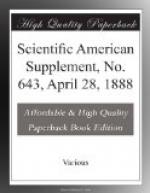The following are the plants put under contribution by the perfume factories of the district, viz., the orange tree, bitter and sweet, the lemon, eucalyptus, myrtle, bay laurel, cherry laurel, elder; the labiates; lavender, spike, thyme, etc.; the umbelliferous fennel and parsley, the composite wormwood and tarragon, and, more delicate than these, the rose, geranium, cassie, jasmin, jonquil, mignonette, and violet.
THE PERFUME FACTORY.
In the perfume factory everything is done by steam. Starting from the engine room at the bottom, the visitor next enters the receiving room, where early in the morning the chattering, patois-speaking natives come to deliver the flowers for the supply of which they have contracted. The next room is occupied with a number of steam-jacketed pans, a mill, and hydraulic presses. Next comes the still room, the stills in which are all heated by steam. In the “extract” department, which is next reached, are large tinned-copper drums, fitted with stirrers, revolving in opposite directions on vertical axes. Descending to the cellar—the coolest part of the building—we find the simple apparatus used in the process of enfleurage. The apparatus is of two kinds. The smaller is a frame fitted with a sheet of stout glass. A number of these, all of the same size, when placed one on the top of the other, form a tolerably air tight box. The larger is a frame fitted with wire netting, over which a piece of molleton is placed. The other rooms are used for bottling, labeling, etc.
The following are some of the details of the cultivation and extraction of perfumes as given in Mr. Warrick’s paper:
ORANGE PERFUMES.
The orange tree is produced from the pip, which is sown in a sheltered uncovered bed. When the young plant is about 4 feet high, it is transplanted and allowed a year to gain strength in its new surroundings. It is then grafted with shoots from the Portugal or Bigaradier. It requires much care in the first few years, must be well manured, and during the summer well watered, and if at all exposed must have its stem covered up with straw in winter. It is not expected to yield a crop of flowers before the fourth year after transplantation. The flowering begins toward the end of April and lasts through May to the middle of June. The buds are picked when on the point of opening by women, boys, and girls, who make use of a tripod ladder to reach them. These villagers carry the fruits (or, rather, flowers) of their day’s labor to a flower agent or commissionnaire, who weighs them, spreads them out in a cool place (the flowers, not the villagers), where they remain until 1 or 2 A.M.; he then puts them into sacks, and delivers them at the factory before the sun has risen. They are here taken in hand at once; on exceptional days as many as 160 tons being so treated in the whole province. After the following season, say end of June, the farmers prune their trees; these prunings are carted to the factory, where the leaves are separated and made use of.




